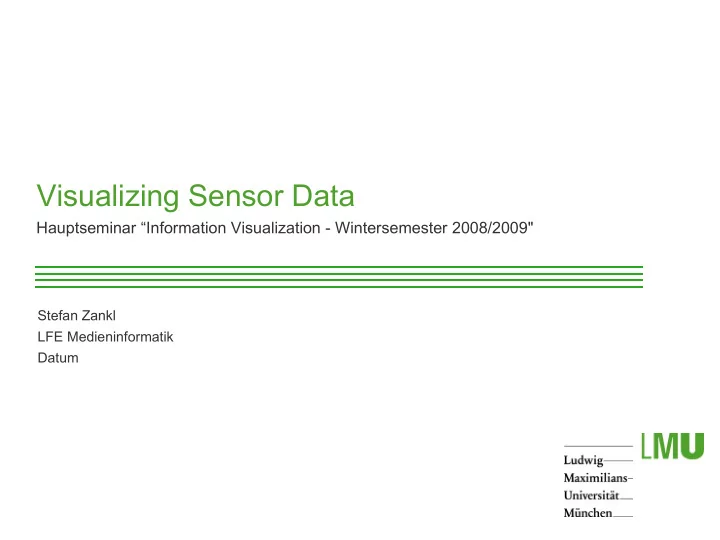

Visualizing Sensor Data Hauptseminar “Information Visualization - Wintersemester 2008/2009" Stefan Zankl LFE Medieninformatik Datum LMU Department of Media Informatics | Hauptseminar WS 2008/2009 | zankls@cip.ifi.lmu.de Slide 1 / XX
Agenda 1. Aspects of sensors 2. Relevance of position and time 3. Aspects of visualization 4. A data type taxonomy 5. Visualizing for a user 6. Visualizing given data 7. Example of a sensor network / visualization LMU Department of Media Informatics | Hauptseminar WS 2008/2009 | zankls@cip.ifi.lmu.de Slide 2 / XX
Aspects of sensors Sensor nodes combine: Sensing components A micro computer A wireless communication device Different kinds of sensors: Acoustic Biological Mechanical Thermal ... Application Areas: Medicine Military Scientific Measurement ... Sources: 1, 8 LMU Department of Media Informatics | Hauptseminar WS 2008/2009 | zankls@cip.ifi.lmu.de Slide 3 / XX
Relevance of position and time Sensor networks mostly used to observe a certain phenomenon → User wants to know, where and when a measured event occured Reasons: Reaction to an event Interest in development over time Possibility to define regions of interest (e.g. „only during the night“) Space and time important components of data fusion ... Node positioning and time synchronization fundamental Fixed installation vs. arbitrary deployement Absolute scales vs. relative scales LMU Department of Media Informatics | Hauptseminar WS 2008/2009 | zankls@cip.ifi.lmu.de Slide 4 / XX
Aspects of visualization Many different kinds of visualization: Graphs Charts Maps Diagrams ... Choice of suitable visualization depends on: Given data Application area Needs of the user ... Sources: 2, 5 LMU Department of Media Informatics | Hauptseminar WS 2008/2009 | zankls@cip.ifi.lmu.de Slide 5 / XX
A data type taxonomy Shneiderman: Taxonomy of visualizations by data type[9] Seven data types: 1-dimensional data: linear data types 2-dimensional data: planar or map data 3-dimensional data: real-world objects Temporal data: have a start and finish time Multidimensional data: points in a n-dimensional space Tree data: hierarchy of items, which have a link to one parent item Network data: items linked to an arbitrary number of items Sources: 3, 7 LMU Department of Media Informatics | Hauptseminar WS 2008/2009 | zankls@cip.ifi.lmu.de Slide 6 / XX
Visualizing for a user Tasks a user generally wants to perform (Shneiderman): Overview: Gain an overview of collection Zoom: Zoom in on special items Filter: Filter out uninteresting items Details-on-demand: Of items or groups Relate: View relationships History: Of actions Extract: Sub-collections Human perception: Preattentive processing Color encodings Source: 6 LMU Department of Media Informatics | Hauptseminar WS 2008/2009 | zankls@cip.ifi.lmu.de Slide 7 / XX
Visualizing given data Too many possible application areas and needs of the user → Limitation of possible visualizations regarding the dimension of the data Aspects of dimension: Position of sensor Time of measurement Number of measurands → Possible classification of sensor data by dimensions: Example: Temperature-sensor monitoring temperature of machine x in a factory → 1-dimensional sensor (temperature), continuously measuring at relative position (machine x) → 2-dimensional data, e.g. to be shown in a line graph LMU Department of Media Informatics | Hauptseminar WS 2008/2009 | zankls@cip.ifi.lmu.de Slide 8 / XX
Example of an existing network SensorWare Systems Sensor Web pods in Huntington Botanical Garden, San Marino, CA: Since June 2000 By now 20 pods, building a permanent wireless sensor network Pods consisting of: radio, microcontroller, battery pack, special packaging and a sensor suite Sensor suite able to sense: air temperature, air humidity, light levels, soil temperature, soil moisture, battery status, own temperature Visualization open to everybody over: http://caupanga.huntington.org/swim/ Source: 4 LMU Department of Media Informatics | Hauptseminar WS 2008/2009 | zankls@cip.ifi.lmu.de Slide 9 / XX
Example of a visualization I Temporal View: Line graphs Interaction panel Style Pods Time of measurement Measurands Source: 2 LMU Department of Media Informatics | Hauptseminar WS 2008/2009 | zankls@cip.ifi.lmu.de Slide 10 / XX
Example of a visualization II Spatial View: Image Pod-Details Interaction panel Time of measurement Measurands Source: 2 LMU Department of Media Informatics | Hauptseminar WS 2008/2009 | zankls@cip.ifi.lmu.de Slide 11 / XX
Example of a visualization III Icon View: Lines of traffic lights Pod-Details Interaction panel Time of measurement Measurands Source: 2 LMU Department of Media Informatics | Hauptseminar WS 2008/2009 | zankls@cip.ifi.lmu.de Slide 12 / XX
Any questions? Thank you! LMU Department of Media Informatics | Hauptseminar WS 2008/2009 | zankls@cip.ifi.lmu.de Slide 13 / XX
References 1. C. Buschmann, D. Pfisterer, S. Fischer, S. Fekete and A. Kröller. SpyGlass: a wireless sensor network visualizer. ACM SIGBED Review, 2(1):1-6, 2005. 2. http://caupanga.huntington.org/swim/ 3. http://maps.google.de/ 4. http://sensorwaresystems.com/historical/resources/pictures/hunt-107.shtml 5. http://service.tagesschau.de/wetter/deutschland/vorhersage.html 6. http://www.csc.ncsu.edu/faculty/healey/PP/index.html 7. http://www.georgehernandez.com/h/aaBlog/2006/media/04-18-World_TreeMap.jpg 8. T. R. Nelson and T. T. Elvins. Visualization of 3D ultrasound data. Computer Graphics and Applications, IEEE, 13(6):50-57, 1993. 9. B. Shneiderman. The eyes have it: a task by data type taxonomy for information visualizations. In Visual Languages, 1996. Proceedings., IEEE Symposium on, pages 336-343, 1996. LMU Department of Media Informatics | Hauptseminar WS 2008/2009 | zankls@cip.ifi.lmu.de Slide 14 / XX
Recommend
More recommend